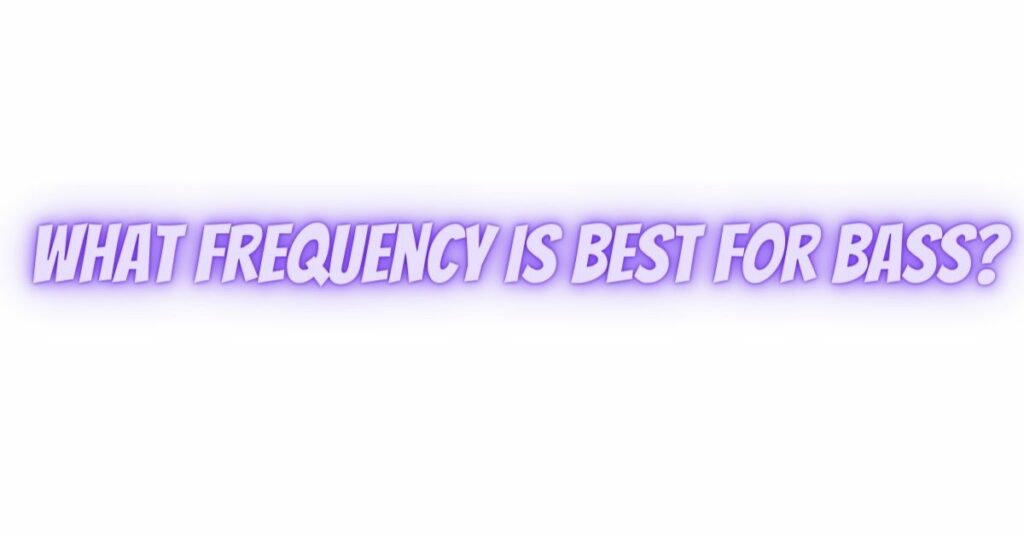Bass frequencies are the foundation of music and audio, providing depth, power, and groove to your listening experience. But what is the best frequency for bass? This question doesn’t have a single, definitive answer, as the ideal bass frequency varies depending on your audio system, musical preferences, and listening environment. In this comprehensive article, we will explore the characteristics of bass frequencies and help you understand how to find the sweet spot for bass in your specific context.
Understanding Bass Frequencies
Bass frequencies, often associated with deep, low tones, encompass a range of frequencies typically between 20 Hz and 250 Hz. In this range, different subcategories of bass frequencies exist:
- Sub-Bass (20-60 Hz): This is the very low end of the bass spectrum, providing rumble and impact. It’s often felt as much as heard and is a key component in creating a visceral audio experience.
- Low Bass (60-120 Hz): These frequencies contribute to the warmth and fullness of bass tones, adding body to the sound without overwhelming it.
- Mid-Bass (120-250 Hz): The mid-bass range is where bass guitar, kick drums, and other fundamental bass elements reside. It provides punch and definition to the bassline.
Finding the Ideal Bass Frequency
The best bass frequency for your audio setup depends on several factors:
- Personal Preference: Your taste in music and audio plays a significant role. Some people prefer deep sub-bass for electronic music, while others may favor a punchier, mid-bass-focused sound for rock or jazz.
- Listening Environment: The acoustics of your room can impact how you perceive bass frequencies. Larger rooms may require more powerful sub-bass, while smaller spaces benefit from tighter, well-controlled bass.
- Audio Equipment: The quality and capabilities of your audio equipment, such as speakers or headphones, affect how bass frequencies are reproduced. High-quality equipment is more likely to render bass accurately and powerfully.
- Content Type: The type of audio content you’re enjoying also plays a role. Movies, video games, and music genres each have their unique bass characteristics. You may want to tailor your bass frequency preferences accordingly.
- Subwoofer Capabilities: If you’re using a subwoofer, its specifications, such as its frequency response range and power, will influence the best bass frequency. Subwoofers are designed to excel in the sub-bass range.
Finding the Best Bass Frequency for Your Context
Here’s how to find the ideal bass frequency for your specific situation:
- Experiment: Start with a flat or neutral EQ setting and listen to your audio content. Take note of what aspects of the bass you want to improve. Is it deeper rumble, more punch, or warmth?
- Address Issues: If you notice that certain frequencies are too prominent or lacking, consider using EQ to adjust them. For example, if you desire more sub-bass rumble, focus on frequencies below 60 Hz. If you want more punch, focus on the mid-bass range.
- Room Acoustics: Address room acoustics. If your room has excessive bass resonance, you might need to reduce specific frequencies through room treatment.
- EQ Adjustments: Use EQ to fine-tune your bass frequencies. Boost or cut in small increments, carefully listening to how each adjustment affects the audio.
- Listen and Compare: A/B testing is a valuable method. Compare your EQ-adjusted sound to the unaltered audio to ensure that your changes are indeed an improvement.
- Genre Consideration: Keep in mind that different music genres and content types may require different bass frequency settings. Electronic music may benefit from pronounced sub-bass, while acoustic recordings may need more emphasis in the mid-bass range.
- Document Your Settings: If you find settings that work well for specific genres or audio content, save and document them. This allows you to easily recall the settings when needed.
Conclusion
The best frequency for bass is a subjective and context-dependent matter. The ideal bass frequency for one listener or situation may not be the same for another. The key is to experiment, carefully listen, and make gradual adjustments to tailor your bass response to your liking and the specific audio content you are enjoying. Whether you’re seeking powerful sub-bass, warm mid-bass, or punchy low bass, finding the right bass frequency is a personalized journey that enhances your overall listening experience.


